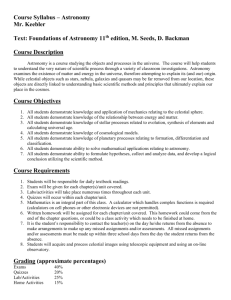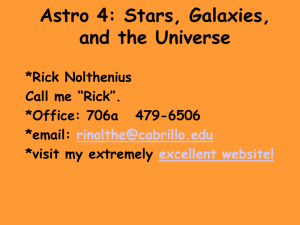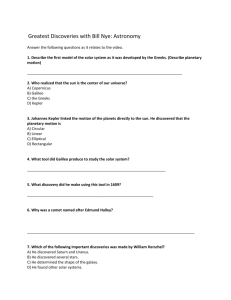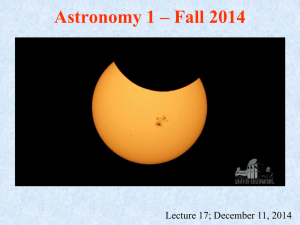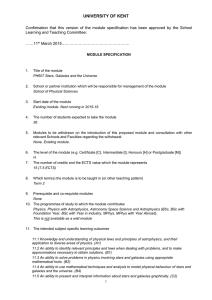Space intro lesson
advertisement
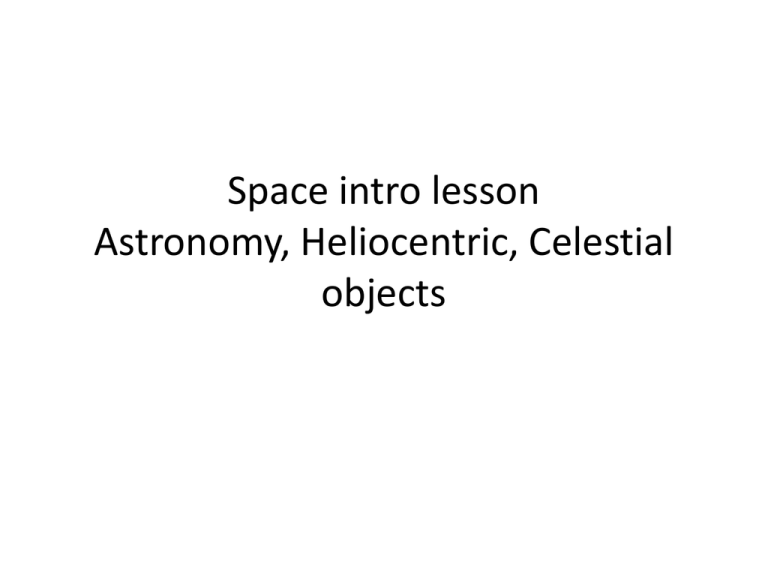
Space intro lesson Astronomy, Heliocentric, Celestial objects Astronomy vs. Astrology What it is Scientific basis Ability to predict future Astrology The study of how the positions of celestial bodies have influence on life events and behavior of people Astronomy The study of the origin, movement and behavior of the universe astrologist NO Astronomer, cosmologist YES, based on repeated observations, simulations and theories NO Zodiac signs YES Constellations 12, first coined by Babylonians 88 Geocentric vs Heliocentric • Earth at the center • Sun at the center Geocentric theory • The ancient Greeks (Aristotle included) noticed moon, sun, and stars revolve in circle around the Earth. • Observationally-based but erroneous • Heaven is “perfect and unchanging”- idea supported by Catholic Church • Galileo Galilei (1564-1642) found Jupiter’s moon with his first telescope; backed Corpecnicus’s heliocentric theory • Clashed with Church; houseconfined for the rest of his life Supermoon on Saturday May 5 2012 Moon is a celestial object •Celestial object: any object seen in the sky. E.g. sun, earth, planets, comets http://www.cbc.ca/video/#/Shows/1221254309/ID=2230765368 The Universe = all existing matter and space considered as a whole; the cosmos. 1. How old is the universe? 13.7 billion years old 2. How do we know how old the universe is? Edwin Hubble (1889-1953) used two different methods: A. Measuring speeds and distances of galaxies and calculate backward to see how long it took for them to reach their current locations B. Measuring the ages of the oldest star clusters. Sorting Galaxies activity Ignore sharp point in pictures; they are stars from our galaxy • In group of 4, come up with your own categories to classify these galaxies • What causes the difference in galaxies’ shapes? Galaxies • A galaxy is a collection of hundreds of billions of stars held together by gravity •A star = a hot ball of plasma that shines because of nuclear fusion taking place at its core •Earth is part of the Milky Way which is a spiral galaxy •Color of galaxy depends on the age of the stars it contains Shaped like spheres or oval Older & are largest galaxies Fewer young stars than spiral galaxies Flat & circular with curving arms Have many young stars Disc-shaped with a bulge in the middle No particular shape Properties of galaxies 1. Galaxies contain about 200 billion stars each and usually have a supermassive BLACK HOLE in their centre 2. At least 90% of the mass in the universe may be composed of dark matter Black Hole • Space where gravity is so strong that it can pull anything right into it. • Masses of stars pulled into black hole increase the size and mass of the original black hole Dark Matter • Invisible matter that make up 90% of the matter in the universe. They provide the gravitational force that hold the universe together • Evidence for presence of dark matter: – Stars around galaxy such as the Milky Way revolve around the galaxy’s centre at such high speed that they are expect to be flung off – But they are not. Dark matter explained: http://www.youtube.com/watch?v=nJN2X3NrQAE Tour of the universe: 3D atlas http://ed.ted.com/lessons/a-3d-atlas-of-the-universe-carteremmart Exit activities Making crossword puzzle for today’s vocab Making inferences with “How far can you see” article Summarizing “Hunting Black Hole” article

